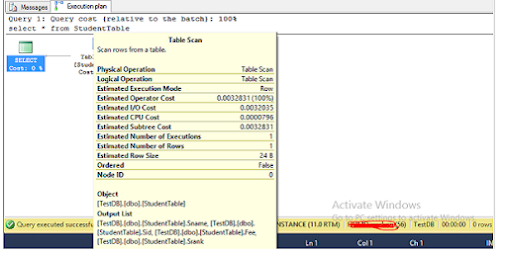Query processing architecture guide
Execution modes
The SQL Server Database Engine can process Transact-SQL statements using two distinct processing modes:
- Row mode execution
- Batch mode execution
Row mode execution
Row mode execution is a query processing method used with traditional RDBMS tables, where data is stored in row format. When a query is executed and accesses data in row store tables, the execution tree operators and child operators read each required row, across all the columns specified in the table schema. From each row that is read, SQL Server then retrieves the columns that are required for the result set, as referenced by a SELECT statement, JOIN predicate, or filter predicate.
Batch mode execution
Batch mode execution is a query processing method used to process multiple rows together (hence the term batch). Each column within a batch is stored as a vector in a separate area of memory, so batch mode processing is vector-based. Batch mode processing also uses algorithms that are optimized for the multi-core CPUs and increased memory throughput that are found on modern hardware.
When it was first introduced, batch mode execution was closely integrated with, and optimized around, the columnstore storage format. However, starting with SQL Server 2019 (15.x) and in Azure SQL Database, batch mode execution no longer requires columnstore indexes. For more information, see Batch mode on rowstore.
Batch mode processing operates on compressed data when possible, and eliminates the exchange operator used by row mode execution. The result is better parallelism and faster performance.
When a query is executed in batch mode, and accesses data in columnstore indexes, the execution tree operators and child operators read multiple rows together in column segments. SQL Server reads only the columns required for the result, as referenced by a SELECT statement, JOIN predicate, or filter predicate. For more information on columnstore indexes, see Columnstore Index Architecture.
SQL statement processing
Processing a single Transact-SQL statement is the most basic way that SQL Server executes Transact-SQL statements. The steps used to process a single SELECT statement that references only local base tables (no views or remote tables) illustrates the basic process.
Logical operator precedence
When more than one logical operator is used in a statement, NOT is evaluated first, then AND, and finally OR. Arithmetic, and bitwise, operators are handled before logical operators. For more information, see Operator Precedence.
In the following example, the color condition pertains to product model 21, and not to product model 20, because AND has precedence over OR
SELECT ProductID, ProductModelID
FROM Production.Product
WHERE ProductModelID = 20 OR ProductModelID = 21
AND Color = 'Red';
GO
You can change the meaning of the query by adding parentheses to force evaluation of the OR first. The following query finds only products under models 20 and 21 that are red.
SELECT ProductID, ProductModelID
FROM Production.Product
WHERE (ProductModelID = 20 OR ProductModelID = 21)
AND Color = 'Red';
GO
Optimize SELECT statements
A SELECT statement is non-procedural; it doesn't state the exact steps that the database server should use to retrieve the requested data. This means that the database server must analyze the statement to determine the most efficient way to extract the requested data. This is referred to as optimizing the SELECT statement. The component that does this, is called the Query Optimizer. The input to the Query Optimizer consists of the query, the database schema (table and index definitions), and the database statistics. The output of the Query Optimizer is a query execution plan, sometimes referred to as a query plan, or execution plan. The contents of an execution plan are described in more detail later in this article.










